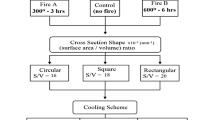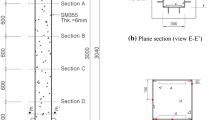Abstract
The present standards for finding the fire ratings of reinforced concrete (RC) columns are restricted to pristine elements, as the age or corrosion-related deteriorations are yet to be addressed. An experimental investigation was conducted to examine the impact of corrosion on the fire performance of reinforced concrete columns. This investigation studied two normal-strength concrete (NSC) and two high-strength concrete (HSC) RC columns. Out of these four columns, one NSC and one HSC column were corroded by a specifically designed accelerated corrosion setup for the target corrosion of 20%, while the remaining columns were the control specimens and were kept uncorroded. After completing the desired exposure time for the accelerated corrosion, both columns and their companion non-corroded columns were tested in a fire furnace simulating the standard ISO-834 fire. The experimental results showed that corrosion has a significant influence on the fire performance of the RC columns. The result indicates that the fire rating of the corroded HSC column drops considerably. Nevertheless, there exists a subtle enhancement in the behavior of the corroded NSC column when exposed to fire, indicating the need for further research in this regard. The effects of corrosion cracks and spalling on the fire resistance of the corroded RC columns were also noted in this study. This research will enable the design of new reinforced concrete columns for better fire performance despite corrosion-related deteriorations.



















Similar content being viewed by others
Abbreviations
- fck :
-
Characteristics compressive strength of concrete
- Ac :
-
Area of concrete
- fy :
-
Yield strength of longitudinal reinforcement
- Asc :
-
Area of longitudinal reinforcement
- fc :
-
Compressive strength of concrete cube of 150 × 150 × 150 (mm) size.
- P:
-
Initially applied load over the column during fire testing
References
Zhang W, Song X, Gu X, Li S (2012) Tensile and fatigue behavior of corroded rebars. Constr Build Mater 34:409–417
Suda K, Misra S, Motohashi K (1993) Corrosion products of reinforcing bars embedded in concrete. Corros Sci 35(5–8):1543–1549
Fang C, Lundgren K, Chen L, Zhu C (2004) Corrosion influence on bond in reinforced concrete. Cem Concr Res 34(11):2159–2167
Coccia S, Imperatore S, Rinaldi Z (2016) Influence of corrosion on the bond strength of steel rebars in concrete. Mater Struct 49(1):537–551
Lundgren K (2007) Effect of corrosion on the bond between steel and concrete: an overview. Mag Concr Res 59(6):447–461
Rodriguez J, Ortega LM, Casal J (1997) Load carrying capacity of concrete structures with corroded reinforcement. Constr Build Mater 11(4):239–248
Rajput AS, Sharma UK (2018) Corroded reinforced concrete columns under simulated seismic loading. Eng Struct 171:453–463
Xia J, Jin WL, Li LY (2016) Performance of corroded reinforced concrete columns under the action of eccentric loads. J Mater Civ Eng 28(1):04015087
Ou YC, Nguyen ND (2016) Influences of location of reinforcement corrosion on seismic performance of corroded reinforced concrete beams. Eng Struct 126:210–223
Liu X, Jiang H, He L (2017) Experimental investigation on seismic performance of corroded reinforced concrete moment-resisting frames. Eng Struct 153:639–652
U.S. Fire Administration (2018) Non-residential building fire trends (2007–2016), Emmitsburg
Kodur V (2014) Properties of concrete at elevated temperatures. International Scholarly Research Notices. https://doi.org/10.1155/2014/468510
Wu H, Lin X, Zhou A (2020) A review of mechanical properties of fibre reinforced concrete at elevated temperatures. Cem Concr Res 135:106117
Cheng FP, Kodur VKR, Wang TC (2004) Stress-strain curves for high-strength concrete at elevated temperatures. J Mater Civ Eng 16(1):84–90
Youssef MA, Moftah M (2007) General stress-strain relationship for concrete at elevated temperatures. Eng Struct 29(10):2618–2634
Morley PD, Royles R (1983) Response of the bond in reinforced concrete to high temperatures. Mag Concr Res 35(123):67–74
Morley PD, Royles R (1980) The influence of high temperature on the bond in reinforced concrete. Fire Saf J 2(4):243–255
IS 3809 (1979) Fire resistance test for structures
Shah AH, Sharma UK (2017) Fire resistance and spalling performance of confined concrete columns. Constr Build Mater 156:161–174
Franssen JM, Dotreppe JC (2003) Fire tests and calculation methods for circular concrete columns. Fire Technol 39(1):89–97
Raut NK, Kodur VKR (2011) Response of high-strength concrete columns under design fire exposure. J Struct Eng 137(1):69–79
Rodrigues JPC, Laím L, Correia AM (2010) Behaviour of fiber reinforced concrete columns in fire. Compos Struct 92(5):1263–1268
Buch SH, Sharma UK (2019) Fire resistance of eccentrically loaded reinforced concrete columns. Fire Technol 55:1517–1552
EN 1992–1–2 (1992) Eurocode 2: Design of concrete structures - Part 1–2: General rules - Structural fire design
C. S. Standards Association of Australia. Committee BD-002, Concrete structures : AS 3600–2009
Yang O, Zhang B, Yan G, Chen J (2018) Bond performance between slightly corroded steel bar and concrete after exposure to high temperature. J Struct Eng 144(11):04018209
Tariq F, Bhargava P (2021) Flexural behaviour of corroded RC beams exposed to fire. Structures, vol 33. Elsevier, Amsterdam, pp 1366–1375
Ba G, Miao J, Zhang W, Liu J (2019) Influence of reinforcement corrosion on fire performance of reinforced concrete beams. Constr Build Mater 213:738–747
IS/ISO 834–1 (1999) Fire-Resistance Tests — Elements of Building Construction: Part 1 General Requirements
IS 456 (2000) Plain and Reinforced Concrete - Code of Practice
(Reapproved:2011) A-03 (2016) Standard practice for preparing, cleaning, and evaluating corrosion test. ASTM G1–03 03:1–9. https://doi.org/10.1520/G0001-03R11.2.
I. Standard, Hardened Concrete-Methods of Test Part 5 Non-Destructive Testing Section Half-Cell Potentials of Uncoated Reinforcing Steel in Concrete, 2021
Ba G, Miao J, Zhang W, Liu C (2016) Influence of cracking on heat propagation in reinforced concrete structures. J Struct Eng 142(7):04016035
Wu B, Xiong W, Wen B (2014) Thermal fields of cracked concrete members in fire. Fire Saf J 66:15–24
Takeda M, Onishi T, Nakakubo S, Fujimoto S (2009) Physical properties of iron-oxide scales on Si-containing steels at high temperature. Mater Trans 50(9):2242–2246
Acknowledgements
The Department of Science and Technology (DST), Government of India, financially supported this experimental investigation program. The authors wish to thank for that.
Author information
Authors and Affiliations
Corresponding author
Ethics declarations
Conflict of interest
The authors whose names are listed immediately below certify that they have NO affiliations with or involvement in any organisation or entity with any financial interest (such as honoraria; educational grants; participation in speakers’ bureaus; membership, employment, consultancies, stock ownership, or other equity interest; and expert testimony or patent-licensing arrangements), or non-financial interest (such as personal or professional relationships, affiliations, knowledge or beliefs) in the subject matter or materials discussed in this manuscript.
Additional information
Publisher's Note
Springer Nature remains neutral with regard to jurisdictional claims in published maps and institutional affiliations.
Rights and permissions
Springer Nature or its licensor (e.g. a society or other partner) holds exclusive rights to this article under a publishing agreement with the author(s) or other rightsholder(s); author self-archiving of the accepted manuscript version of this article is solely governed by the terms of such publishing agreement and applicable law.
About this article
Cite this article
Chandra, S., Sharma, U.K., Green, M. et al. Fire Performance of Corroded Reinforced Concrete Columns. Fire Technol (2023). https://doi.org/10.1007/s10694-023-01472-x
Received:
Accepted:
Published:
DOI: https://doi.org/10.1007/s10694-023-01472-x




